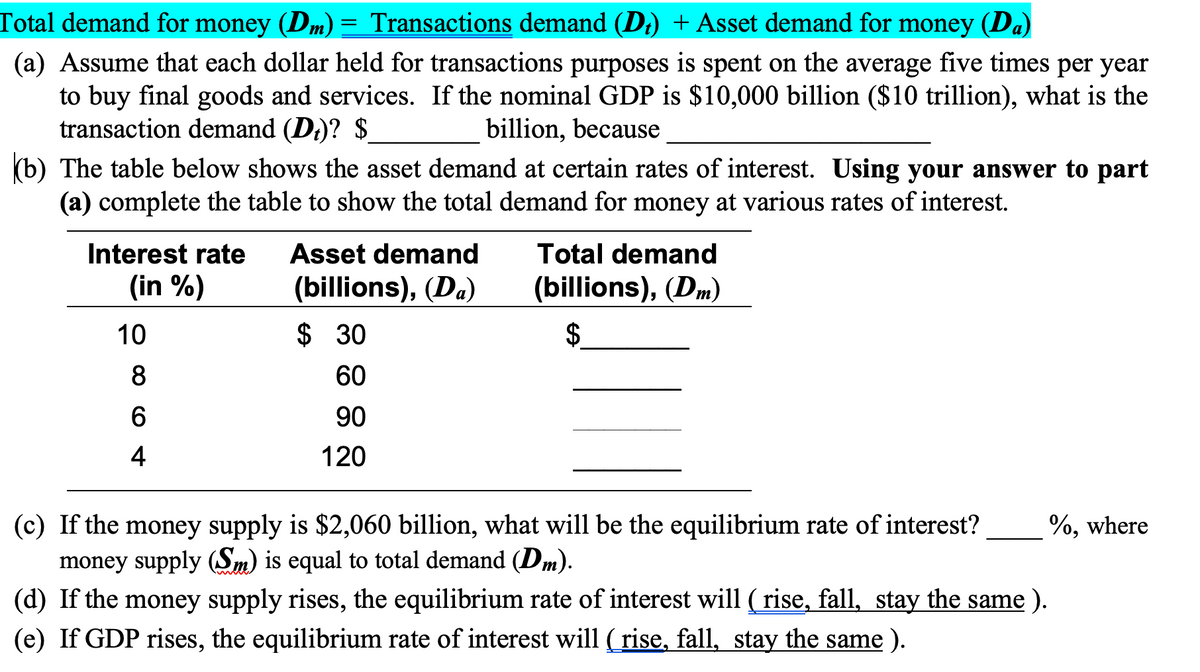a) Assume that each dollar held for transactions purposes is spent on the average five times per year to buy final goods and services. If the nominal GDP is $10,000 billion ($10 trillion), what is the transaction demand (D¿)? $ billion, because b) The table below shows the asset demand at certain rates of interest. Using your answer to part (a) complete the table to show the total demand for money at various rates of interest. Interest rate Asset demand Total demand (in %) (billions), (Da) $ 30 (billions), (Dm) 10 $. 60
a) Assume that each dollar held for transactions purposes is spent on the average five times per year to buy final goods and services. If the nominal GDP is $10,000 billion ($10 trillion), what is the transaction demand (D¿)? $ billion, because b) The table below shows the asset demand at certain rates of interest. Using your answer to part (a) complete the table to show the total demand for money at various rates of interest. Interest rate Asset demand Total demand (in %) (billions), (Da) $ 30 (billions), (Dm) 10 $. 60
Chapter1: Making Economics Decisions
Section: Chapter Questions
Problem 1QTC
Related questions
Question

Transcribed Image Text:Total demand for money (Dm) = Transactions demand (D;) + Asset demand for money (Da)
(a) Assume that each dollar held for transactions purposes is spent on the average five times per year
to buy final goods and services. If the nominal GDP is $10,000 billion ($10 trillion), what is the
transaction demand (Di)? $
billion, because
(b) The table below shows the asset demand at certain rates of interest. Using your answer to part
(a) complete the table to show the total demand for money at various rates of interest.
Interest rate
Asset demand
Total demand
(in %)
(billions), (Da)
(billions), (Dm)
10
$ 30
$.
8
60
6
90
4
120
(c) If the money supply is $2,060 billion, what will be the equilibrium rate of interest?
money supply (Sm) is equal to total demand (Dm).
(d) If the money supply rises, the equilibrium rate of interest will (rise, fall, stay the same ).
(e) If GDP rises, the equilibrium rate of interest will ( rise, fall, stay the same ).
%, where
Expert Solution
This question has been solved!
Explore an expertly crafted, step-by-step solution for a thorough understanding of key concepts.
This is a popular solution!
Trending now
This is a popular solution!
Step by step
Solved in 5 steps

Knowledge Booster
Learn more about
Need a deep-dive on the concept behind this application? Look no further. Learn more about this topic, economics and related others by exploring similar questions and additional content below.Recommended textbooks for you


Principles of Economics (12th Edition)
Economics
ISBN:
9780134078779
Author:
Karl E. Case, Ray C. Fair, Sharon E. Oster
Publisher:
PEARSON

Engineering Economy (17th Edition)
Economics
ISBN:
9780134870069
Author:
William G. Sullivan, Elin M. Wicks, C. Patrick Koelling
Publisher:
PEARSON


Principles of Economics (12th Edition)
Economics
ISBN:
9780134078779
Author:
Karl E. Case, Ray C. Fair, Sharon E. Oster
Publisher:
PEARSON

Engineering Economy (17th Edition)
Economics
ISBN:
9780134870069
Author:
William G. Sullivan, Elin M. Wicks, C. Patrick Koelling
Publisher:
PEARSON

Principles of Economics (MindTap Course List)
Economics
ISBN:
9781305585126
Author:
N. Gregory Mankiw
Publisher:
Cengage Learning

Managerial Economics: A Problem Solving Approach
Economics
ISBN:
9781337106665
Author:
Luke M. Froeb, Brian T. McCann, Michael R. Ward, Mike Shor
Publisher:
Cengage Learning

Managerial Economics & Business Strategy (Mcgraw-…
Economics
ISBN:
9781259290619
Author:
Michael Baye, Jeff Prince
Publisher:
McGraw-Hill Education